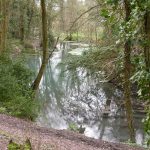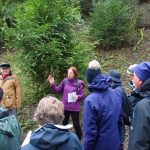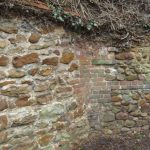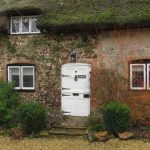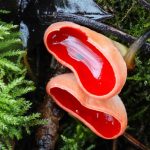Despite grey skies and steady drizzle, 21 members and guests turned out on the morning of Saturday 27 January for another of Lesley Dunlop’s excellent geology walks. The walk started from the front of the church of St Michael and All Angels in Lambourn. In the churchyard were many snowdrops and a few crocuses. Lesley pointed out a high-status house across the road which was faced on one side by dressed sarsen stones, which would have dated from before the time of mechanical cutting tools. It also had both headers and stretchers of the more expensive blue-glazed bricks. Beside the path towards Lynch Wood was a big block of sarsen stone with two characteristic holes formed by tree roots. Lesley explained that sarsens are lumps of hard sandstone, formed by localised patchy cementation of the Tertiary sands which formerly covered the Chalk. Fossil root holes indicate that this cementation occurred near the surface. Evaporation of ground water in the warm Tertiary period would have concentrated dissolved silica to the point where locally it crystallised out, cementing the sand grains together. Subsequent erosion of the uncemented bulk of the Tertiary beds left these hardened blocks behind as sarsen stones.
Normally there are pools and bubbling springs in the lower part of Lynch Wood, forming the headwaters of the River Lambourn. But despite the recent rains, the pools were completely dry, indicating that the aquifers had not yet been replenished following the previous year’s very dry winter. Snowdrops carpeted the lower part of the wood, while Box and Hart’s-tongue Fern were abundant on the steep slope above the path. Scarlet Elfcup fungi were spotted, growing up through moss on dead wood. Lesley pointed out the contrast between the steep side of the valley on the right of the path and the much shallower gradient on the left. This is a characteristic feature of dry valleys on the Chalk. In the time of the ice ages, when permafrost prevented water from draining through the Chalk and instead rivers of meltwater carved out dry valleys, south and west facing slopes warmed up more quickly and suffered more erosion. The walk continued along a track which led northwards along the top of the ridge. The root plate of a fallen tree showed a shallow layer of Clay-with-flints above the Chalk, and the top layer of Chalk had been crumbled by frost action into small stones. Looking across the valley, Lesley pointed out clumps of trees on the ridge tops. These mark patches of Clay-with-flints, formed by freeze-thaw at the top of the Chalk. Lower down the valley of the River Lambourn, ridge-top trees mark layers of the sandy Lambeth Beds lying above the Chalk. A Fox was spotted in the field beside the track. The route continued down to Upper Lambourn, where there were some interesting walls and cottages. One cottage had big coigns (corner stones) of chalk blocks at the top of the wall, but with a big sarsen block at the bottom. Another cottage had been extended several times. Part of it had grey knapped sarsen stones, while another section had orange-coloured rough sarsen stones.
Pictures by Sue White and Laurie Haseler


